
Catalog excerpts

Printed in China Part No. 480-086-P Owner’s Manual VHF MARINE RADIO MR F75 Nothing comes close to a Cobra® English
Open the catalog to page 1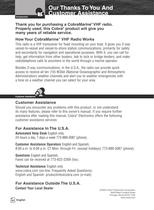
Thank you for purchasing a CobraMarinë" VHF radio. Properly used, this Cobra® product will give you many years of reliable service. How Your CobraMarinë VHF Radio Works This radio is a VHF transceiver for fixed mounting on your boat. It gives you 2-way vessel-to-vessel and vessel-to-shore station communications, primarily for safety and secondarily for navigation and operational purposes. With it, you can call for help, get information from other boaters, talk to lock or bridge tenders, and make radiotelephone calls to anywhere in the world through a marine operator. Besides 2-way...
Open the catalog to page 2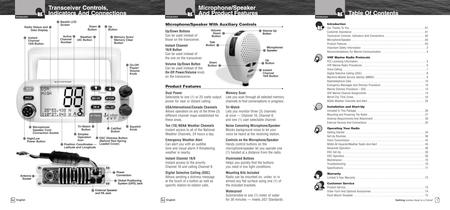
Transceiver Controls, Indicators And Connections Introduction Radio Status and Data Display Instant Channel 16/9 Button Backlit LCD Screen Active Channel Number Down Button Weather/ UIC Button Introduction Microphone/Speaker And Product Features Introduction Microphone/Speaker With Auxiliary Controls Up Button Memory Scan/ Memory Clear Button On-Off Power/ Volume Knob Up/Down Buttons Can be used instead of those on the transceiver. Volume Down Button Volume Up Button Talk Button Instant Channel 16/9 Button Can be used instead of the one on the transceiver. Volume Up/Down Button Can be used...
Open the catalog to page 3
Important Safety Information Before installing and using your CobraMarine" VHF radio, please read these general precautions and warnings. Warning And Caution Statements To make the most of this radio, it must be installed and used properly. Please read the installation and operating instructions carefully before installing and using it. Special attention must be paid to the WARNING and CAUTION statements in this manual. Statements identify conditions that could result in personal injury or loss of life. Statements identify conditions that could cause damage to the radio Safety Training...
Open the catalog to page 4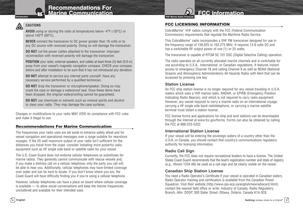
AVOID using or storing the radio at temperatures below -4°F (-20°C) or NEVER connect the transceiver to DC power greater than 16 volts orto any DC source with reversed polarity. Doing so will damage the transceiver. DO NOT cut the power cables attached to the transceiver. Improper reconnection with reversed polarity will damage the transceiver. POSITION your radio, external speakers, and cables at least three (3) feet (0.9 m) away from your vessel's magnetic navigation compass. CHECK your compass before and after installation to be sure that it has not introduced any deviation DO NOT...
Open the catalog to page 5
VHF Marine Radio Protocols User Responsibility And Operating Locations All users are responsible for observing domestic and foreign government regulations and are subject to severe penalties for violations. The VHF frequencies on your radio are reserved for marine use and require a special license to operate from land, including when your boat is on its trailer. This device complies with part 15 of the FCC Rules. Operation is subject to the following two (2) conditions: (1 ) This device may not cause harmful interference, and (2) This device must accept any interference received, including...
Open the catalog to page 6
VHF Marine Radio Protocols The vessel Corsair calling the vessel Vagabond: Corsair: "Vagabond, this is Corsair." Vagabond: "Corsair, this is Vagabond. Reply 72 (or any proper working channel)." ■ After communications are completed, each vessel must sign off with its call sign or vessel name and switch to Channel 16. For best sound quality at the station you're calling, hold the microphone/speaker at least two (2) inches [five (5) cm] from your mouth and slightly off to one (1) side. Speak in a normal tone of voice. Digital Selective Calling (DSC)_ Digital selective calling is a...
Open the catalog to page 7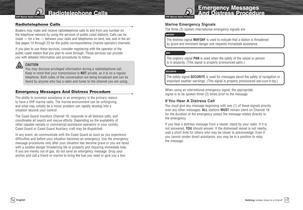
VHF Marine Radio Protocols Radiotelephone Calls Boaters may make and receive radiotelephone calls to and from any number on the telephone network by using the services of public coast stations. Calls can be made — for a fee — between your radio and telephones on land, sea, and in the air. See pages 14 through 23 for the public correspondence (marine operator) channels. If you plan to use these services, consider registering with the operator of the public coast station that you plan to work through. Those services can provide you with detailed information and procedures to follow. You may...
Open the catalog to page 8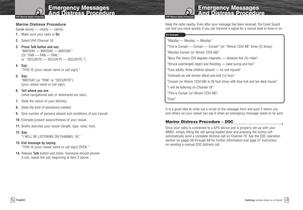
VHF Marine Radio Protocols ViViT* ■ »Jkl U^K^fi MOWÍÍ» ini' Marine Distress Procedure Speak slowly — clearly — calmly. 1. Make sure your radio is On. 3. Press Talk button and say: "MAYDAY — MAYDAY — MAYDAY." or "SECURITE — SECURITE — SECURITE.") "THIS IS [your vessel name or call sign]." [your vessel name or call sign]. (what navigational aids or landmarks are near). 7. State the nature of your distress. 8. State the kind of assistance needed. 9. Give number of persons aboard and conditions of any injured. 10. Estimate present seaworthiness of your vessel. 11. Briefly describe your vessel...
Open the catalog to page 9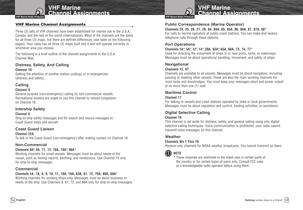
VHF Marine Radio Protocols VHF Marine Channel Assignments_< Three (3) sets of VHF channels have been established for marine use in the U.S.A., Canada, and the rest of the world (International). Most of the channels are the same for all three (3) maps, but there are definite differences (see table on the following pages). Your radio has all three (3) maps built into it and will operate correctly in whichever area you choose. The following is a brief outline of the channel assignments in the U.S.A. Distress, Safety, And Calling Getting the attention of another station (calling) or in...
Open the catalog to page 10
VHF Marine Radio Protocols Channel Number Channel Map Frequency USA Int’l Canada Transmit Receive 01 01A • • • 06 • • 07 07A 08 09 10 11 12 • • • • • • • • • • • • • • • • • • • • • 156.050 160.650 01 156.050 01A 156.100 160.700 02 Public Correspondence (Marine Operator) 156.150 160.750 03 Public Correspondence (Marine Operator) 156.150 03A 160.800 04 156.200 156.200 04A 160.850 05 156.250 156.250 05A 156.300 156.300 06 Intership Safety 156.350 • 05 Use 156.250 • 04A 05A Channel 156.200 • • • 04 Power Limits 156.150 • • 03 VHF Marine Radio Protocols VHF Marine Channel Assignments 156.050 •...
Open the catalog to page 11All Cobra catalogs and brochures
-
DASH 2316D
2 Pages
-
29 LX BT
2 Pages
-
29 LX MAX
2 Pages
-
CPP 9000
2 Pages
-
CPI 2590
2 Pages
-
CPI 1590
2 Pages
-
CPI 1090
2 Pages
-
CPI 890
2 Pages
-
CPI 490
2 Pages
-
MR F45-D
2 Pages
-
Cobra-AdventureHD-5200
2 Pages
-
Cobra Adventure HD 5210
2 Pages
-
WASPcam_9905Wi-Fi
2 Pages
-
WASPcam 9906CAMO
2 Pages
-
WASPcam 99074K
2 Pages
-
CDR 835
2 Pages
-
CDR 855 BT
2 Pages
-
CDR875G
2 Pages
-
CDR 895 D
2 Pages
-
C 75 WX ST
2 Pages
-
19 DX IV
2 Pages
-
18 WX ST II
2 Pages
-
29 LTD CHR
2 Pages
-
25 LTD
2 Pages
-
29 NW
2 Pages
-
25 NW
2 Pages
-
29 LTD
2 Pages
-
RAD 350
2 Pages
-
MR F55-D
2 Pages
-
MR F77B GPS
2 Pages
-
MR HH450 DUAL
2 Pages
-
MR HH350W FLT
2 Pages
-
MR HH350 FLT
2 Pages
-
MR F55B-D
2 Pages
-
MR HH125
2 Pages
-
MR F77W GPS
2 Pages
-
MR HH450 CAMO
2 Pages
-
MR F57B
2 Pages
-
MR HH425LI VP
42 Pages
-
MR HH325 VP
35 Pages
-
MC 600CI
102 Pages
Archived catalogs
-
MR F80 manual
83 Pages











































